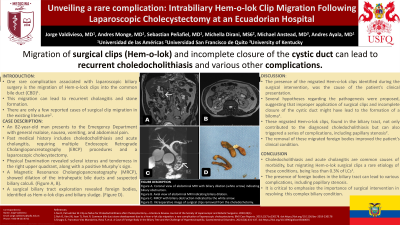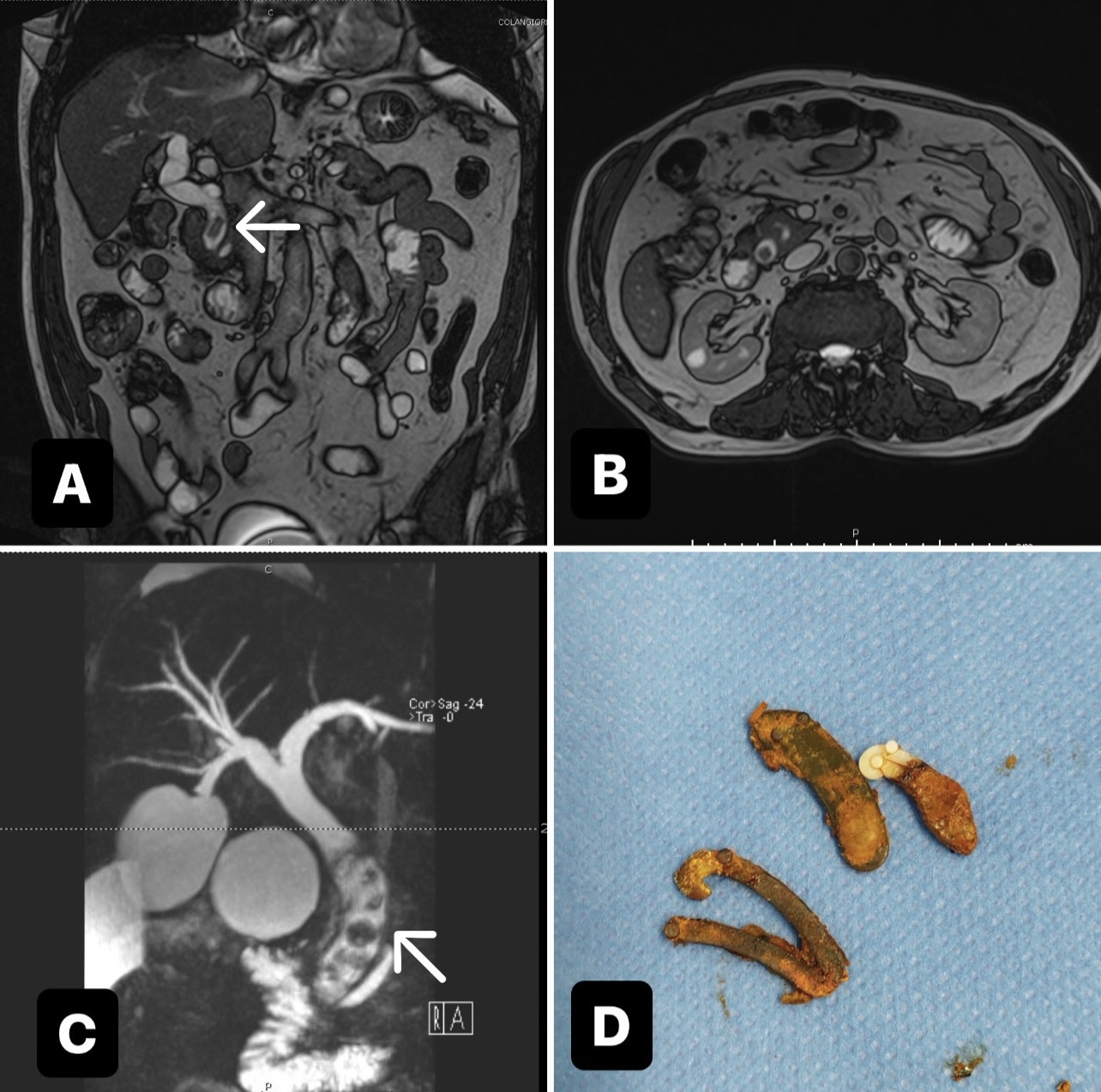Tuesday Poster Session
Category: Biliary/Pancreas
P3577 - Unveiling a Rare Complication: Intrabiliary Hem-o-lok Clip Migration Following Laparoscopic Cholecystectomy at an Ecuadorian Hospital
Tuesday, October 29, 2024
10:30 AM - 4:00 PM ET
Location: Exhibit Hall E

Has Audio

Jorge Andres Andres Valdivieso, MD
Universidad de Las Américas
Lexington, KY
Presenting Author(s)
Jorge Andres Valdivieso, MD1, Andres Ricardo Monge, MD1, Wilson Sebastian Penafiel, MD1, Michella Dirani Benitez, MS2, Michael I. Anstead, MD3, Andres Vinicio Ayala, MD1
1Universidad de Las Américas, Quito, Pichincha, Ecuador; 2Universidad San Francisco de Quito, Quito, Pichincha, Ecuador; 3University of Kentucky, Lexington, KY
Introduction: Gallstone disease and cholelithiasis affect approximately 10% to 15% of adults. Endoscopic retrograde cholangiopancreatography (ERCP) is the preferred method for treating gallstone disease through stone extraction, with surgical common bile duct exploration (CBDE) reserved as a last resort. One rare complication associated with laparoscopic biliary surgery is the migration of Hem-o-lok clips into the common bile duct (CBD). This migration can lead to recurrent cholangitis and may be a focal point for stone formation. Despite its clinical significance, there are only a few reported cases of surgical clip migration in the existing literature.
Case Description/Methods: An 82-year-old man arrived at the emergency department with complaints of general malaise, nausea, and vomiting. His medical history is notable for choledocholithiasis and acute cholangitis, requiring multiple surgical interventions, including five episodes of endoscopic retrograde cholangiopancreatography (ERCP) and laparoscopic cholecystectomy. Physical examination revealed scleral icterus and tenderness in the right upper quadrant, along with a positive Murphy's sign. Further investigations, including magnetic resonance cholangiopancreatography (MRCP), showed dilation of the intrahepatic bile ducts and likely calculi. A scheduled biliary tract exploration uncovered foreign bodies identified as Hem-o-lok clips and biliary sludge.
Discussion: The presence of foreign bodies identified during the surgical intervention reveals a key triggering factor in the patient's clinical presentation. Several hypotheses regarding the pathogenesis were proposed. Raoul et al. suggested that improper application of surgical clips and incomplete closure of the cystic duct might lead to the formation of a biloma. These foreign elements, found in the biliary tract, not only contributed to the diagnosed choledocholithiasis but can also triggered a series of complications, including papillary stenosis. The presence and subsequent removal of these foreign bodies emerge as a determinant factor in the genesis of the patient's acute cholangitis and choledocholithiasis, underscoring the critical importance of surgical intervention in addressing this complex biliary condition.

Disclosures:
Jorge Andres Valdivieso, MD1, Andres Ricardo Monge, MD1, Wilson Sebastian Penafiel, MD1, Michella Dirani Benitez, MS2, Michael I. Anstead, MD3, Andres Vinicio Ayala, MD1. P3577 - Unveiling a Rare Complication: Intrabiliary Hem-o-lok Clip Migration Following Laparoscopic Cholecystectomy at an Ecuadorian Hospital, ACG 2024 Annual Scientific Meeting Abstracts. Philadelphia, PA: American College of Gastroenterology.
1Universidad de Las Américas, Quito, Pichincha, Ecuador; 2Universidad San Francisco de Quito, Quito, Pichincha, Ecuador; 3University of Kentucky, Lexington, KY
Introduction: Gallstone disease and cholelithiasis affect approximately 10% to 15% of adults. Endoscopic retrograde cholangiopancreatography (ERCP) is the preferred method for treating gallstone disease through stone extraction, with surgical common bile duct exploration (CBDE) reserved as a last resort. One rare complication associated with laparoscopic biliary surgery is the migration of Hem-o-lok clips into the common bile duct (CBD). This migration can lead to recurrent cholangitis and may be a focal point for stone formation. Despite its clinical significance, there are only a few reported cases of surgical clip migration in the existing literature.
Case Description/Methods: An 82-year-old man arrived at the emergency department with complaints of general malaise, nausea, and vomiting. His medical history is notable for choledocholithiasis and acute cholangitis, requiring multiple surgical interventions, including five episodes of endoscopic retrograde cholangiopancreatography (ERCP) and laparoscopic cholecystectomy. Physical examination revealed scleral icterus and tenderness in the right upper quadrant, along with a positive Murphy's sign. Further investigations, including magnetic resonance cholangiopancreatography (MRCP), showed dilation of the intrahepatic bile ducts and likely calculi. A scheduled biliary tract exploration uncovered foreign bodies identified as Hem-o-lok clips and biliary sludge.
Discussion: The presence of foreign bodies identified during the surgical intervention reveals a key triggering factor in the patient's clinical presentation. Several hypotheses regarding the pathogenesis were proposed. Raoul et al. suggested that improper application of surgical clips and incomplete closure of the cystic duct might lead to the formation of a biloma. These foreign elements, found in the biliary tract, not only contributed to the diagnosed choledocholithiasis but can also triggered a series of complications, including papillary stenosis. The presence and subsequent removal of these foreign bodies emerge as a determinant factor in the genesis of the patient's acute cholangitis and choledocholithiasis, underscoring the critical importance of surgical intervention in addressing this complex biliary condition.

Figure: MRCP reveals foreign bodies in the common bile duct corresponding to hemo-o-lok clips (A, B, C). Hemo-o-lok clips after surgical removal (D)
Disclosures:
Jorge Andres Valdivieso indicated no relevant financial relationships.
Andres Ricardo Monge indicated no relevant financial relationships.
Wilson Sebastian Penafiel indicated no relevant financial relationships.
Michella Dirani Benitez indicated no relevant financial relationships.
Michael Anstead indicated no relevant financial relationships.
Andres Vinicio Ayala indicated no relevant financial relationships.
Jorge Andres Valdivieso, MD1, Andres Ricardo Monge, MD1, Wilson Sebastian Penafiel, MD1, Michella Dirani Benitez, MS2, Michael I. Anstead, MD3, Andres Vinicio Ayala, MD1. P3577 - Unveiling a Rare Complication: Intrabiliary Hem-o-lok Clip Migration Following Laparoscopic Cholecystectomy at an Ecuadorian Hospital, ACG 2024 Annual Scientific Meeting Abstracts. Philadelphia, PA: American College of Gastroenterology.

